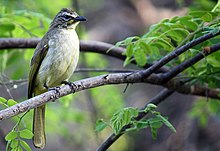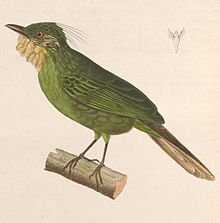Bulbüls
| Bulbüls | ||||||||||||
|---|---|---|---|---|---|---|---|---|---|---|---|---|

Rotohrbülbül ( Pycnonotus jocosus ) |
||||||||||||
| Systematics | ||||||||||||
|
||||||||||||
| Scientific name | ||||||||||||
| Pycnonotidae | ||||||||||||
| Gray, GR , 1840 |
The Bulbüls or hair birds ( Pycnonotidae) are a family of passerine birds (Passeriformes). They occur mainly in the tropical regions of Asia and Africa and feed mainly on fruits. The name Bülbül comes from Turkish from Persian (بُلبُل, DMG bolbol ) and means nightingale .
features
Bulbüls are medium-sized songbirds, which can reach body sizes similar to the Central European sparrows to blackbirds from 14 to 28 centimeters. The neck is very short, as are the wings, on the other hand they have a rather long tail that looks slightly cut off and notched at the end. The legs are thin and the feet have very delicate claws. The plumage consists of relatively long and soft feathers that are very loose, especially on the back. All Bülbüls have thin hair feathers on their necks, which have earned them the name hair birds. These feathers can become very long in some species.
They are sometimes very conspicuously colored and, depending on the species, can have yellow, red and orange body parts. Most species are inconspicuous, however, olive brown, yellow or brown to black. Species like the Rotohrbülbül ( Pycnonotus jocosus ) also have a conspicuous hood made of head feathers. In particular, parts of the abdomen, the throat, the forehead, the cheeks or parts of the lower plumage at the base of the tail can be contrasted in color. There is no sexual dimorphism , so the males and females are colored the same, only the young birds are often a little or significantly darker.
distribution and habitat
The majority of the Bülbüls live in Africa and Madagascar . Here are the representatives of the most different species as endemics found while only in South Asia, only two species are native. Both the real Bülbüls (genus Pycnonotus ) and the Weißkehlbülbüls (genus Criniger ) and the flight birds (genus Hypsipetes ) occur with species in both areas. In the Middle East, the Yellow Bulbul ( Pycnonotus xanthopygos ) can be found, whose range extends from southern Turkey to the Arab countries and Israel. However, many species are also endemic in very small areas of distribution, including the Seychelles Bulbül ( Hypsipetes crassirostris ), which only lives in the Seychelles .
Most species are found in the lowlands, only a few are also found in the mountains. The latter include the yellow- striped bulbul ( Phyllastrephus flavostriatus ) in the mountain forests of Central Africa and the gray-headed bulbul ( Pycnonotus tephrolaemus ) on Ruwenzori in East Africa. The Blasswangenbülbül ( Pycnonotus flavescens ) can even be found at an altitude of 3,500 meters in the moss forest of the mountains on Borneo.
All Bülbüls are standing birds . Many species have adapted to life near human settlements and populate urban gardens, parks, and cemeteries accordingly. They are very trusting and can also be tamed. The Rotohrbülbül and the Yellow-bellied Bulbül ( Pycnonotus goiavier ) are particularly known for their fondness for cities. Other species tend to live in seclusion on the edge of the forest or in forests. The so far seldom seen Bülbül is the Nieuwenhuis-Bülbül , of which only two individual finds from Sumatra and Borneo are known.
Way of life
singing
Bulbüls are mostly lively birds with a conspicuous and loud verse song. This is usually a lively chirping, with some species such as the yellow-crowned bulbül ( Pycnonotus zeylanicus ), however, also performing long and sometimes complex songs from always the same stanzas, which are comparable to those of the nightingale . The song of the Tonkibülbül ( Pycnonotus cafer ) consists of two changing tones . The Streifenkehlbülbül ( Pycnonotus finlaysoni ) and the Madagascar flight bird ( Hypsipetes madagascariensis ) also have a memorable and melodic reputation.
nutrition
Bulbuls live mainly on fruits, mainly berries . Some species are very fixated on individual fruits such as the African Graubauchbülbül ( Pycnonotus gracilirostris ), which sometimes covers kilometers in large swarms in search of ripe figs . Some species like this are accordingly feared and hunted as fruit pests. However, other species also hunt insects or look for worms and other small animals as food, the yellow-crowned bulbul hunts for freshwater snails in bodies of water .
Reproduction
Bulbüls build open nests from twigs and root fibers, which they usually put in forks in the lower areas of the trees. These are padded with leaves or moss. The females lay up to five mostly pale pink to white eggs in their nests and incubate them. For the Graubülbül ( Pycnonotus barbatus ) it is assumed that it lives monogamous and accordingly mates for life. The females breed in this species for about twelve days and are fed by the male. After hatching, both parents feed the young birds with insects. The young birds fledge after about two weeks.
Systematics
The oldest fossil evidence for Bülbüls comes from the Pleistocene about a million years ago. The following genera and species are currently assigned to the Bülbüls:
-
Spizixos
- Finkenbülbül ( Spizixos canifrons )
- Halsbandbülbül ( Spizixos semitorques )
-
Real Bulbüls ( Pycnonotus )
- Gelbscheitelbülbül ( Pycnonotus zeylanicus )
- Stripe Bulbul ( Pycnonotus striatus )
- Strichelbülbül ( Pycnonotus leucogrammicus )
- Goldbürzelbülbül ( Pycnonotus tympanistrigus )
- Mourning Bulbul ( Pycnonotus melanoleucos )
- Graukopfbülbül ( Pycnonotus priocephalus )
- Schwarzkopfbülbül ( Pycnonotus atriceps )
- Andamanenbülbül ( Pycnonotus fuscoflavescens )
- Sri Lankan Goldbrustbülbül ( Pycnonotus melanicterus )
- Goldbrustbülbül ( Pycnonotus flaviventris )
- Sunda Goldbrustbülbül ( Pycnonotus dispar )
- Kerala Goldbrustbülbül ( Pycnonotus gularis )
- Borneo Goldbrustbülbül ( Pycnonotus montis )
- Schuppenbülbül ( Pycnonotus squamatus )
- Graubauchbülbül ( Pycnonotus cyaniventris )
- Rotohrbülbül ( Pycnonotus jocosus )
- Braunbrustbülbül ( Pycnonotus xanthorrhous )
- Chinabülbül ( Pycnonotus sinensis )
- Taiwanbülbül ( Pycnonotus taivanus )
- Himalayan bulbül ( Pycnonotus leucogenys )
- Weißohrbülbül ( Pycnonotus leucotis )
- Russbülbül ( Pycnonotus cafer )
- Kotilangbülbül ( Pycnonotus aurigaster )
- Gelbsteißbülbül ( Pycnonotus xanthopygos )
- Maskenbülbül ( Pycnonotus nigricans )
- Kapbülbül ( Pycnonotus capensis )
- Graubülbül ( Pycnonotus barbatus )
- Somalibülbül ( Pycnonotus somaliensis )
- Dodsonbülbül ( Pycnonotus dodsoni )
- Dreifarbbülbül ( Pycnonotus tricolor )
- Wollrückenbülbül ( Pycnonotus eutilotus )
- Blaubrillenbülbül ( Pycnonotus nieuwenhuisii )
- Yellow-eyed Bulbül ( Pycnonotus urostictus )
- Goldzügelbülbül ( Pycnonotus bimaculatus )
- Streifenkehlbülbül ( Pycnonotus finlaysoni )
- Goldkehlbülbül ( Pycnonotus xantholaemus )
- Schmuckbülbül ( Pycnonotus penicillatus )
- Gelbwangenbülbül ( Pycnonotus flavescens )
- Augenstreifbülbül ( Pycnonotus goiavier )
- White browbulbul ( Pycnonotus luteolus )
- Malaienbülbül ( Pycnonotus plumosus )
- Graustirnbülbül ( Pycnonotus cinereifrons )
- Blanfordbülbül ( Pycnonotus blanfordi )
- Weißaugenbülbül ( Pycnonotus simplex )
- Rotaugenbülbül ( Pycnonotus brunneus )
- Salvadoribülbül ( Pycnonotus erythropthalmos )
- Nacktgesichtsbülbül ( Pycnonotus hualon )
-
Arizelocichla
- Arizelocichla kakamegae
- Eincolorbülbül ( Arizelocichla montana )
- Bergwaldbülbül ( Arizelocichla tephrolaema )
- Arizelocichla kikuyuensis
- Schwarzkappenbülbül ( Arizelocichla nigriceps )
- Ulugurubülbül ( Arizelocichla neumanni )
- Northern Bergwaldbülbül ( Arizelocichla fusciceps )
- Southern Bergwaldbülbül ( Arizelocichla chlorigula )
- Olivbrustbülbül ( Arizelocichla milanjensis )
- Arizelocichla olivaceiceps
- Arizelocichla striifacies
-
Stelgidillas
- Schmalschnabelbülbül ( Stelgidillas gracilirostris )
-
Eurillas
- Grünbülbül ( Eurillas virens )
- Zwergbülbül ( Eurillas gracilis )
- Ansorgebülbül ( Eurillas ansorgei )
- Alexanderbülbül ( Eurillas curvirostris )
- Yellow-bearded Bulbül ( Eurillas latirostris )
-
Andropadus
- Schlichtbülbül ( Andropadus importunus )
-
Calyptocichla
- Goldbülbül ( Calyptocichla serinus )
-
Baeopogon
- Weißschwanzbülbül ( Baeopogon indicator )
- Sjöstedtbülbül ( Baeopogon clamans )
-
Ixonotus
- Fleckenbülbül ( Ixonotus guttatus )
-
Chlorocichla
- Dotterbülbül ( Chlorocichla laetissima )
- Prigoginebülbül ( Chlorocichla prigoginei )
- Yellow-bellied Bulbul ( Chlorocichla flaviventris )
- Falkensteinbülbül ( Chlorocichla falkensteini )
- Hartlaubbülbül ( Chlorocichla simplex )
-
Atimastillas
- Yellow-throated Bulbul ( Atimastillas flavicollis )
-
Thescelocichla
- Raphiabülbül ( Thescelocichla leucopleura )
-
Phyllastrephus
- Uferbülbül ( Phyllastrephus scandens )
- Laubbülbül ( Phyllastrephus terrestris )
- Schillingsbülbül ( Phyllastrephus strepitans )
- Pale belly bulbul ( Phyllastrephus cerviniventris )
- Angolabülbül ( Phyllastrephus fulviventris )
- Baumannbülbül ( Phyllastrephus baumanni )
- Torobülbül ( Phyllastrephus hypochloris )
- Lorenzbülbül ( Phyllastrephus lorenzi )
- Fischerbülbül ( Phyllastrephus fischeri )
- Cabanisibülbül ( Phyllastrephus cabanisi )
- Keniabülbül ( Phyllastrephus placidus )
- Bamendabülbül ( Phyllastrephus poensis )
- Zeisigbülbül ( Phyllastrephus icterinus )
- Xavierbülbül ( Phyllastrephus xavieri )
- Fleckflügelbülbül ( Phyllastrephus leucolepis )
- Schuppenstirnbülbül ( Phyllastrephus albigularis )
- Yellow Stripe Bulbul ( Phyllastrephus flavostriatus )
- Phyllastrephus alfredi
- Schlankbülbül ( Phyllastrephus debilis )
- Usambarabülbül ( Phyllastrephus albigula )
-
Bleda
- Redstarteda ( Bleda syndactylus )
- Green- Tailed Bleda ( Bleda eximius )
- Little Green- tailed Bleda ( Bleda notatus )
- Graukopfbleda ( Bleda canicapillus )
-
Criniger
- Western Haarbülbül ( Criniger barbatus )
- Eastern Haarbülbül ( Criniger chloronotus )
- Swainsonbülbül ( Criniger calurus )
- Weißbartbülbül ( Criniger ndussumensis )
- Olive backbulbül ( Criniger olivaceus )
-
Alophoixus
- Finschbülbül ( Alophoixus finschii )
- Weißkehl-Haubenbülbül ( Alophoixus flaveolus )
- Pale-bellied hooded bulb ( Alophoixus pallidus )
- Rostbauchbülbül ( Alophoixus ochraceus )
- Grauwangenbülbül ( Alophoixus bres )
- Alophoixus frater
- Schwefelbülbül ( Alophoixus phaeocephalus )
-
Acritillas
- Goldbrauenbülbül ( Acritillas indica )
-
Setornis
- Long-billed bulbul ( Setornis criniger )
-
Tricholestes
- Bristle coat bulb ( Tricholestes criniger )
-
Iole
- Burmabülbül ( Iole virescens )
- Grauaugenbülbül ( Iole propinqua )
- Brown bellied bulbul ( Iole olivacea )
- Goldaugenbülbül ( Iole palawanensis )
-
Ixos
- Nicobarenbülbül ( Ixos nicobariensis )
- Grünflügelbülbül ( Ixos mcclellandii )
- Strichelbrustbülbül ( Ixos malaccensis )
- Sumatrabülbül ( Ixos virescens )
-
Thapsinillas
- Goldschwanzbülbül ( Thapsinillas affinis )
- Sulabülbül ( Thapsinillas longirostris )
- Thapsinillas mysticalis
-
Hemixos
- White-throated bulbül ( Hemixos flavala )
- Hainan's white-throated bulbul ( Hemixos cinereus )
- Malaya white-throated bellbulb ( Hemixos castanonotus )
-
Hypsipetes
- Dickschnabelbülbül ( Hypsipetes crassirostris )
- Reunionbülbül ( Hypsipetes borbonicus )
- Mauritiusbülbül ( Hypsipetes olivaceus )
- Madagascar red-billed bulbul ( Hypsipetes madagascariensis )
- Comoros Rotschnabelbülbül ( Hypsipetes parvirostris )
- Mohelibülbül ( Hypsipetes moheliensis )
- China Rotschnabelbülbül ( Hypsipetes leucocephalus )
- India red-billed bulbul ( Hypsipetes ganeesa )
- Rotbrustbülbül ( Hypsipetes philippinus )
- Mindorobülbül ( Hypsipetes mindorensis )
- Hypsipetes guimarasensis
- Zamboangabülbül ( Hypsipetes rufigularis )
- Schieferkopfbülbül ( Hypsipetes siquijorensis )
- Everettbülbül ( Hypsipetes everetti )
- Orpheusbülbül ( Hypsipetes amaurotis )
-
Cerasophila
- Thompsonbülbül ( Cerasophila thompsoni )
-
Neolestes
- Rüttelbülbül ( Neolestes torquatus )
-
Malia
- Mooswaldtimalie ( Malia grata )
People and Bulbuls
As already mentioned, some Bulbül species live very close to humans and are very trusting. Some species are hunted or at least driven away as fruit pests in their areas of distribution, especially those that occur in larger schools. However, many species are also kept as pets. There is an international market for these animals as they are known to be lively and happy to sing. They are particularly popular in their homeland, but they are also regularly offered in Europe and the USA.
The Rotohrbülbül was settled as a neozoon in southern California, where it is actually not native. Other species have been introduced by humans in Australia , the Mascarene Islands and other islands.
literature
- Bertram E. Smythies: Family Hair Birds. In: Grzimeks Tierleben Volume 9 (Birds 3). Kindler, Zurich 1970, pp. 191–197










